DOWNLOADS
Shakthi Peethas in South India
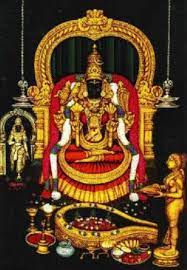 Counted among one of the Shakti Peetha’s, this is the place where the Navel or Nabhi of Goddess Sati fell when Lord Vishnu’s Sudarshana Chakra touched Goddess Sati’s body. The temple is also believed as the center of the earth or eastern hemisphere. There is a belief that after taking birth for killing Asur Bhandasur, Devi sat here taking “Kanya Swarup.” The idol is “Swayambhu,” which signifies it has appeared and not created. She is believed to have three Swarups in the temple. These include Sthula, Sukshama, and Shunya.
Counted among one of the Shakti Peetha’s, this is the place where the Navel or Nabhi of Goddess Sati fell when Lord Vishnu’s Sudarshana Chakra touched Goddess Sati’s body. The temple is also believed as the center of the earth or eastern hemisphere. There is a belief that after taking birth for killing Asur Bhandasur, Devi sat here taking “Kanya Swarup.” The idol is “Swayambhu,” which signifies it has appeared and not created. She is believed to have three Swarups in the temple. These include Sthula, Sukshama, and Shunya.
Goddess Kamakshi created the mud idol of Lord Shiva in Kanchi to worship him. To test her worship, Lord Shiva incarnated himself as Kamba River which has high tides. But the Goddess did not let the mud idol erode in tides. She grasped it closely with her hands. She also prayed on a needle tip that was surrounded by 5 fires (Panchakagni) to free her from the livelihood interest. Lord Shiva became happy with her worship and married her.
There are various Shiva temples in Kanchi, but “Sri Kamakshi Amman Temple” is the only one with the Goddess Sanctorum. Eight Shakti Goddesses also surround the temple. There was a standing image of Kamakshi Devi in Gold. This is a pose in which she prayed and is called Bangaru Kamakshi. An attack was expected at the temple, so the image in Gold gets shifted to Thanjavur.
Lord Shiva and Vishnu surround Kamakshi temple situated in the heart of Kanchipuram. On one side, there are various Shiva temples and few Vishnu temples and is referred as big or Shiva Kanchi. The other side of the Kamakshi temple has big Vishnu temples and some Shiva temples too. This side is known as small or Vishnu Kanchi.
shiva and Kamakshi’s marriage is celebrated in Phalgun month that falls in February or March. There is a belief that people who are getting married should come and attend this festival.
Goddess Kamakshi is taken on a boat ride on this special day. Rukmani temple in Dwarka also celebrates this day.
• Sharda Navratri and Chaitra are celebrated here in the same way as other Devi Temples of India. Special celebrations take place every full moon day or Purnima.
• Brahmotsava is celebrated in Magh that is in January or February. During this time, the idol is taken every morning and evening out. Kamakshi Devi rides on Golden lion on the 4th day and on the silver chariot on the 9th day. Then on the final or 10th day that is also a full moon, all the devotees and Goddess take a holy dip in the temple tank.
• Kamakshi Amman rides in Gold chariot on Chaitra month’s first day.
• Four worships are offered every day.
• Navaratri, Sankara Jayanthi, Aadi, Vasanta Utsavam, and Aippasi Pooram are the other festivals celebrated in this temple.
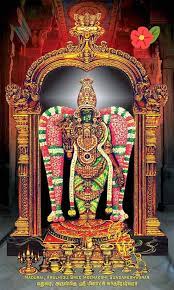 Madurai Meenakshi Temple, one of the most iconic landmarks of Southern India, is a living testimony to the grandeur of ancient Indian architecture and art. Located in the heart of the vibrant city of Madurai, this temple is dedicated to the goddess Meenakshi, also known as Parvati, and her consort, Lord Shiva. The temple complex, with its towering gopurams (gateway towers) and intricately carved pillars, is a true masterpiece that has stood the test of time for over 2000 years. In this blog, we will delve into the fascinating history of the Madurai Meenakshi Temple, explore its timings and rituals, and also provide you with useful information on how to reach this magnificent temple.
Madurai Meenakshi Temple, one of the most iconic landmarks of Southern India, is a living testimony to the grandeur of ancient Indian architecture and art. Located in the heart of the vibrant city of Madurai, this temple is dedicated to the goddess Meenakshi, also known as Parvati, and her consort, Lord Shiva. The temple complex, with its towering gopurams (gateway towers) and intricately carved pillars, is a true masterpiece that has stood the test of time for over 2000 years. In this blog, we will delve into the fascinating history of the Madurai Meenakshi Temple, explore its timings and rituals, and also provide you with useful information on how to reach this magnificent temple.
History of Madurai Meenakshi Temple
The temple is considered to be one of the oldest and most significant temples in India, with a Madurai Meenakshi Amma Temple history that dates back more than 2500 years. According to legend, the temple was built by the Pandya king, Kulasekara Pandya, in the 6th century CE. The king was childless and prayed to Lord Shiva for a child. He was blessed with a daughter who was later named Meenakshi. She was considered to be an incarnation of the goddess Parvati, and at the age of 21, she took over the reins of the kingdom and ruled with great wisdom and justice. Meenakshi later met Lord Shiva, and they fell in love. They were married in a grand ceremony, which was attended by all the gods and goddesses. The temple was built to celebrate their marriage and to honor the goddess Meenakshi.
Over the years, the temple has undergone several renovations and additions, with the most significant one being done during the reign of the Nayak dynasty in the 16th century. They added the towering gopurams (gateway towers), which are considered to be some of the finest examples of Dravidian architecture. Today, the Madurai Meenakshi Temple is a popular tourist destination and a significant pilgrimage site for Hindus. The temple complex covers an area of 15 acres and has 14 magnificent gopurams, each one adorned with intricate carvings and sculptures. Madurai Meenakshi temple architecture is a true masterpiece of art and a testament to the rich cultural heritage of India.
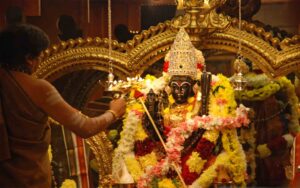 Sri Puruhutika Devi temple is located within the temple complex of Kukkuteswara Swamy, on the outskirts of the village Pithapuram in East Godavari district, Andhra Pradesh. Pithapuram is around 12 kms from Samalkota and 20 kms from Kakinada and 62 kms from Rajahmundry.
Sri Puruhutika Devi temple is located within the temple complex of Kukkuteswara Swamy, on the outskirts of the village Pithapuram in East Godavari district, Andhra Pradesh. Pithapuram is around 12 kms from Samalkota and 20 kms from Kakinada and 62 kms from Rajahmundry.
On entering the temple there is a pond which is called as Padagaya sarovaram (Pada Gaya Sarovar). Pilgrims take holy bath in this pond. Main temple of Kukkuteswara swamy is present towards the right side of the pond. Puruhutika Devi temple is present in the North-East corner of the Kukkuteswara swamy temple. It is constructed facing south. Puruhutika Devi temple is small in size but looks very nice with the carvings of Ashtadasa Shakti peethas on its walls. It is believed that the original statue of Devi is buried under the temple in the same place. This complex has a Sarovar after taking bath people offer prayers to their ancestors, as this temple complex is called Pada Gaya. It has Gayasura’s Padas (Feet) and Vishnu Padas (Feet). Gayasura’s body was cut in three portions and out of that Head has fallen at Siro Gaya (Called Gaya in Bihar) Below chest (Nabhi) portion has fallen in Nabhi Gaya (Jajpur in Orissa)and the Legs (Padas) have fallen here hence called Pada Gaya.
Once Indra had cheated Ahalya, wife of Gautama maharshi by disguising himself in the form of Gautama and was cursed by the Maharshi. Indra lost his testis and got the symbols of Yoni all over his body. He felt very sad and prąyed to Gautama a lot. Finally the Rishi accepted his prayers and told that the Yoni symbols will look like eyes, so that Indra will be called as Sahasraksha thereafter. But Indra lost his testis. He wanted to regain them. He left his kingdom, came to Piithika puri and did Tapasya, offering his prayers to Jaganmata. After a long time Jaganmata appeared before him and blessed him with wealth and testis. Indra was very happy and prąyed her as Puruhutika Devi (One who was worshiped by Indra). Puruhutika Devi Temple is inside the campus of Sri Kukkuteswara Swamy Temple. It is one of the Asta Dasha Shakti Peethas. After Daksha Yagna, Goddess Sati Devi's body part (back part) has fell down in this area, because of this place earlier people has called as Puruhoothika puram later it has changed as Peetika Puram. Finally it has changed Pithapuram. This temple is considered as the 10th Sakthi Peetham of the 18 Shakti Peethas.
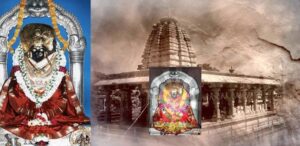 Alampur is a sleepy town situated on the banks Tungabhadra River, in the state of Telangana. Alampur is considered as the western gateway of Srisailam. Here the marvelous temple and remains of some ancient temple signify Badami Chalukyan architecture. The region was ruled by many South Indian dynasties. The principal deities at the Jogulamba temple are Jogulamba and Balabrahmeshwara. Goddess Jogulamba is considered the 5th Shakti Peeta among 18 shakti peetams in the country. Here Goddess Jogulamba is seen seated on the Corpse with scorpion, frog, and lizard on the head. She is seen in a naked avtar with her tongue stretched outside, an avtar of fierce goddess that grants Siddhi in Yoga and hence called Jogulamba. This word is a changed form of Yogula Amma in Telugu which means Mother of Yogis.
Alampur is a sleepy town situated on the banks Tungabhadra River, in the state of Telangana. Alampur is considered as the western gateway of Srisailam. Here the marvelous temple and remains of some ancient temple signify Badami Chalukyan architecture. The region was ruled by many South Indian dynasties. The principal deities at the Jogulamba temple are Jogulamba and Balabrahmeshwara. Goddess Jogulamba is considered the 5th Shakti Peeta among 18 shakti peetams in the country. Here Goddess Jogulamba is seen seated on the Corpse with scorpion, frog, and lizard on the head. She is seen in a naked avtar with her tongue stretched outside, an avtar of fierce goddess that grants Siddhi in Yoga and hence called Jogulamba. This word is a changed form of Yogula Amma in Telugu which means Mother of Yogis.
According to a popular legend there was a great saint in 6th century called Rasa Siddha who had the power to convert base metal into gold and he was considered close to chalukya king Pulakesi II, instrumental in constructing any temples called ‘Nava Brahmas’. According to the legend, the nine names of Siva are actually the names of medicinal herbs put forth by Rasa Siddha and there are nine temples here. They are the Swarga Brahma Temple Padma Brahma Temple, Vishva Brahma Temple Arka Brahma Temple, Bala Brahma Temple, Garuda Brahma Temple, and Taraka Brahma Temple. The Siddha Rasarnavam is a tantric work, which states that if upasana is performed as per the prescribed Tantra, then Mercury oozes from the Linga of Bala Brahma, Thighs of Subramanya, Navel of Ganapati, and Mouth of Mother Jogulamba, which can be converted into Gold by using the medicinal herbs.
The popular temple stands as a testimony to Chalukya Art and Culture. The Tungabhadra and Krishna are seen in a confluence near Alampur, and hence it is also known as Dakshina Kailasam. It is also said that Brahma had performed a great penance at today’s Alampur for thousands of years, and he pleased Lord Siva who conferred the powers of creation for him. Hence, the deity is also called Brahmeswara and the goddess as Yogini or Jogulamba, a synonym for mother Parvathi.
Temple Timings :
All Days of the Week
7:00 AM – 1:00 PM
2:00 PM – 8:30 PM
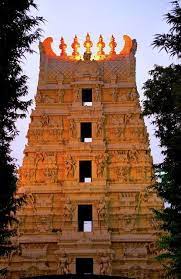 Srisailam, a hill town in Kurnool district of Andhra Pradesh is home to the holy Malikarjuna Jyotirlinga and also as one of the eighteen Shakti Peethas of goddess Parvati. Situated on the banks of river Krishna, Srisailam is identified with a wildlife sanctuary and a dam.
Srisailam, a hill town in Kurnool district of Andhra Pradesh is home to the holy Malikarjuna Jyotirlinga and also as one of the eighteen Shakti Peethas of goddess Parvati. Situated on the banks of river Krishna, Srisailam is identified with a wildlife sanctuary and a dam.
You could seek the blessings of the almighty by visiting the many majestic temples in the city such as the one dedicated to Lord Shiva (it is renowned as Sikhareswara Swamy temple) or the famous Bhramaramba Mallikarjunaswamy Temple which is located at a height of around 457m from sea level. The Nallamala forest ranges with multifarious flora and fauna lie in close proximity to the Srisailam hills.
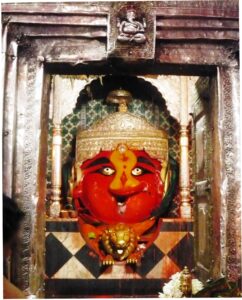 Devi Renuka/ Yelluai/ Yellamma, the princess of Emperor Prasenjit of ancient India, is worshiped as the goddess of the fallen. Worshipers of the goddess are found in rural Karnataka, Andhra Pradesh and Maharashtra. Apart from Mahurgad in Maharashtra, Renuka Mata appeared in various avatars like Yamai, Ekvira, Mohta, Padmakshi Renuka for demon slaying and for the welfare of devotees. Devotees consider her as “mother of the whole world” i.e. “Jagdamba”.
Devi Renuka/ Yelluai/ Yellamma, the princess of Emperor Prasenjit of ancient India, is worshiped as the goddess of the fallen. Worshipers of the goddess are found in rural Karnataka, Andhra Pradesh and Maharashtra. Apart from Mahurgad in Maharashtra, Renuka Mata appeared in various avatars like Yamai, Ekvira, Mohta, Padmakshi Renuka for demon slaying and for the welfare of devotees. Devotees consider her as “mother of the whole world” i.e. “Jagdamba”.
Yallamma Devi is considered to be a form of Kali herself. One hand of Yallamma Devi is the destroyer of ego and the other hand is the benefactor of the devotees. Goddess Yellamma is mainly worshiped in South India and there she is known by various names such as Mahakali, Jogamma, Somalamma, Gunddamma, Pochamma, Maisamma, Jagadambika, Holiamma, Renukamata, Yellamma, Mariamma and Renuka Devi. The temple shown in the picture below is located at Mahurgad near the village of Mahur in the tribal area of Nanded district of Maharashtra state, India.
Renuka was the princess of an ancient Indian king named Prasenjit, and the wife of the sage Jamadagni. The couple had five sons, one of whom was Parashuram.
The Renuka Devi temple is situated on top of a hill and is surrounded by caves. One has to climb about 200-250 steps to reach the temple. There are temples of Lord Parashuram and Lord Dattatreya in this area. Renukadevi is decorated with various gold ornaments like gold flower earrings, gold garlands, nose rings.
Mahur is a very religious place and there are many temples around it. The place is surrounded by forests rich in teak trees and wild life. Mahur was an important fort in Berar history.
Priests perform various pujas to idols. Devotees are allowed to perform Aarti on their own in Renuka Devi Temple.
• Temple Timings: 6.00 am to 10.00 pm.
• There are about 200-250 steps to reach the temple. Dollies are available for those who cannot climb.
Famous festivals
• January – Makar Sankranti
• October – Navratri, Vijayadashami
• November >- Diwali
• December – Dattatreya Jayanti (December/January)
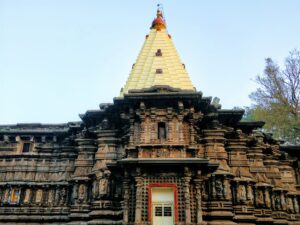 The Shri Mahalakshmi Temple of Kolhapur in Maharashtra, India, is one of the Shakti Peethas also called Dakshin Kashi, listed in various puranas of Hinduism. According to these writings, a shakti peetha is a place associated with Shakti, the goddess of power. The Kolhapur peetha is of special religious significance, being one of the six places where it is believed one can either obtain salvation from desires or have them fulfilled. The temple takes its name from Mahalakshmi, the consort of Vishnu, and it is believed that the divine couple reside in the area.
The Shri Mahalakshmi Temple of Kolhapur in Maharashtra, India, is one of the Shakti Peethas also called Dakshin Kashi, listed in various puranas of Hinduism. According to these writings, a shakti peetha is a place associated with Shakti, the goddess of power. The Kolhapur peetha is of special religious significance, being one of the six places where it is believed one can either obtain salvation from desires or have them fulfilled. The temple takes its name from Mahalakshmi, the consort of Vishnu, and it is believed that the divine couple reside in the area.
The temple belongs, architecturally, to the Kannada Chalukya empire, and may have been first built circa 700 AD. Mounted on a stone platform, the image of the four armed and crowned goddess is made of gemstone and weighs about 40 kilograms. The image of Mahalakshmi carved in black stone is 3 feet in height. The Shri yantra is carved on one of the walls in the temple. A stone lion, the vahana of the goddess, stands behind the statue.
The crown contains an image of the Sheshnag — the serpent of Vishnu. In Her four hands, the deity of Mahalakshmi holds objects of symbolic value. The lower right hand holds a mhalunga (a citrus fruit), in the upper right, a large mace (kaumodaki) with its head touching the ground, in the upper left a shield (khetaka), and in the lower left, a bowl (panpatra).
Unlike most Hindu sacred images, which face north or east, the image of this deity looks west (Pashchim). There is a small open window on the western wall, through which the light of the setting sun falls on the face of the image for three days around the 21st of each March and September.
Architecture of Mahalaxmi Temple, Kolhapur
The four Shakti Peethas of Maharashtra are Tuljapur enshrining Bhavani, Kolhapur enshrining Mahalakshmi, Mahur enshrining Mahamaya Renukaand Saptshringi enshrining Jagadamba. Other Shakti temples in the state are those at Ambe Jogai and Aundh.Kolhapur is located in Kolhapur district and is well connected with Pune, 240 km north. It is on the national highway between Bangalore and Pune. It is situated on the banks of the Panchganga river and is full of ancient temples and shrines.
Legends: The Karavira Mahatmya states that Vishnu resides in the form of Mahalakshmi at Kolhapur. Legend has it that Kolhasura, a demon that tormented the Gods and other beings, was destroyed by Mahalakshmi here at Karavira, and that the spot of his death became a thirtha and that she took abode here in a shrine which constitutes the temple today. (Legend also has it that Parvati – Kolhambika destroyed the demon Kolhasura at Tryambakeshwar).
History: Although several parts of the temple are of the second half of the second millennium CE, epigraphic references place the deity in the 7th century CE, and the temple in the 10th century CE. For a period in the interim, this temple had fallen out of worship and the image of the Goddess was housed elsewhere. Worship was restored in the year 1715 after the Marathas rose to power.
The Temple: The main entrance Mahadwara of the temple is the western entrance. Upon entering the Mahadwara one is confronted with several deepamaalas on either side, and enters the Garuda mandap with square pillars and foliated arches of wood, characteristic of Maratha temples. This mandap dates back to the 18th century. An image of garuda faces the sanctum. Another stone mandap, on a raised platform enshrining Ganesh, also faces the sanctum. Following this is the mandap with three shrines facing west. The central one is that of Mahalakshmi and the two on either side are those of Mahakali and Mahasaraswathi.
The temple complex exhibits mortarless construction echoing the style of the early Deccan temples. Also to be noted here are the horizontal mouldings and the vertical offsets which create a rich light and shade pattern. Also seen in this temple is a rich display of sculpture of figurines in dancing poses, musicians, gods and goddesses. The three sancta have rather simple shikharas of brick and mortar dating back to the 19th century.
The image of Mahalakshmi carved in black stone is 3 feet in height. The Shri yantra is carved on one of the walls in the temple. The sanctum is designed such that once a year, the setting rays of the sun fall on the face of the image of Mahalakshmi for a period of 3 days in the months of Pisces and Leo.
Above the Mahalakshmi sanctum is a shrine with a Shivalingam and a nandi. The devakoshtas house Venkatesha, Katyayani and Gowri Shankar – facing the north, east and the south. There are a number of subsidiary shrines in the courtyard to the Navagrahas, Surya, Mahishasuramardini, Vitthal-Rakhmai, Shiva, Vishnu, Tulja Bhavani and others. Some of these images date back to the 11th century, while some are of recent origin. Also located in the courtyard is the temple tank Manikarnika Kund, on whose bank is a shrine to Visweshwar Mahadev.
Worship: Five worship services are offered each day here. The first one is at 5 am, and it involves the waking of the deity with a Kakada – torch, to the accompaniment of hymns. The second worship service at 8 am involves the offeirng of the Shodashopachara pooja consisting of 16 elements. The afternoon and evening services and the Shejaarati pooja constitute the three other services.
A festival image of the deity is taken out in procession around the temple courtyard each Friday, and on full moon days.
4.00 a.m. Opening of the Temple Entrance Gate.
4.00 a.m. to 4.30 a.m Ghantanaad (Ringing of the bell)
4.45 a.m. Opening of Main Door by the High Priest (Hakkadar Pujari) for that day.
5.30 a.m. Padhya Pooja (Washing the feet of the idol Goddess Mahalaxmi by Milk.)
5.45 a.m. Kakada Aarati of the Goddess Mahalaxmi.
8.30 a.m. Ghantanaad (Ringing of the bell) and Snan Abhishek (Bathing of the main idol. Goddess Mahalaxmi)
9.30 a.m. Aarati and Shankh Trith
11.30 a.m. Ghantanaad and Abhishek (Milk Bathing of the main idol. Goddess Mahalaxmi)
12.30 to 1.00 p.m. Aarati and Shankh Tirth
1.30 to 2.30 p.m. Alankar Pooja. Salankruti
(i.e. Goddess is decorated with beautiful Gold ornaments, Sari and Blouse) This Pooja is kept upto 8.30 p.m. in the evening
8.00 p.m. Ghantanaad (Ringing of the bell)
8.15 p.m. Aarati
8.30 p.m. to 9.00 p.m. Mantrapushp and removing the Alankar (Gold ornaments.) and simple Pooja is performed
10.00 p.m. Ghantanaad (Ringing of the bell)
10.15 p.m. Shejarati (Last Aarti of the day.)
10.30 p.m. Temple’s Doors are closed.
Other Important Rituals Performed
• Every Friday at 9.30 p.m.- Devichi Palakhi (i.e. procession of the idol Goddess Mahalaxmi in Palainquin.)
• On every Chaitra Pratipada – Procession of the idol Goddess Mahalaxmi is carried out in Chariot and Palainquin at 9.30 p.m. (Nagar Pradakshana)
• Procession of the Idol Goddess Mahalaxmi is carried out in Palainquin on every full Moon (Poornima) of Ashwin, Kartik, Margshirsh, Paush and Magh at 9.30 p.m.
• Palakhi (Procession) of the idol Goddess Mahalaxmi is carried out in Palainquin, daily during Navratri Ashwin pratipada upto Dasara Festival.
• Mahaprasad (Delicious Food) is distributed to thousands of Devoties after 12.00 p.m. on Ashwin Poornima. (full Moon)
• Abhishek and Kumkumarchan (Bathing the idol of Goddess Mahalaxmi with Milk and applying Kumkum on to the feets of the idol), are allowed to perform by male devoties only between 5.30 a.m. to 12.30 p.m.
